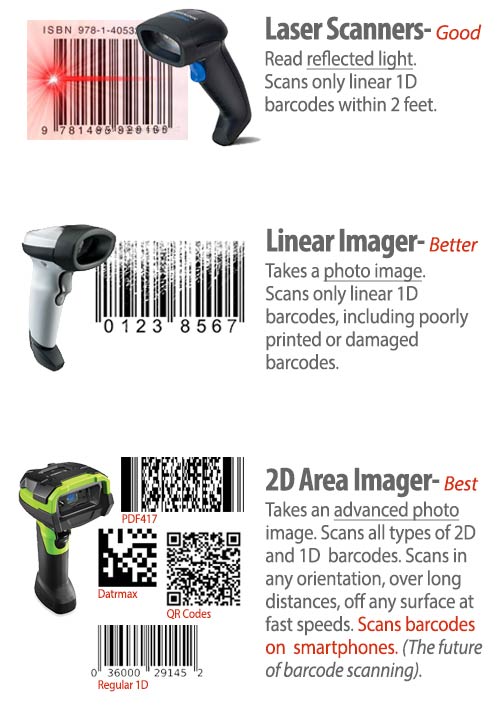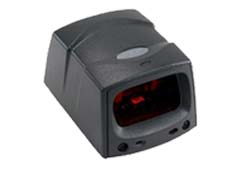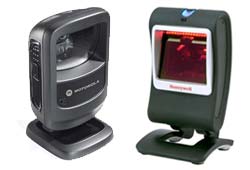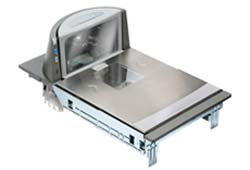Barcode Scanner Information Guide
There are two main types of scannable barcodes: one dimensional (1D) and two dimensional (2D). One-dimensional, or linear, barcodes were the first barcode type to be used. They hold a limited amount of information and are still common today. Two-dimensional barcodes can hold more information and offer expanded options compared to their 1D counterparts.
One-dimensional (1D) or linear barcodes have been used since 1974. They can only hold up to 25 characters, depending on the type. 1D laser scanners were developed to reflect light off of the barcode and read the information that bounces back.
2D barcodes can hold up to 2,000 characters because they read both horizontally and vertically. Two-dimensional (2D) barcode scanners are called area imagers and scan by taking a picture of the barcode. The image is optimized for contrast and decoded to read the information. 2D barcode scanners work on both 2D and 1D barcodes.

1D laser barcode scanners capture information by reflecting light onto the barcode and reading the reflected information. They’re economical to purchase; however, they are limited to a 2-24 inch scanning range. They also struggle to read damaged barcodes.
1D linear imagers use CCD technology, similar to a digital camera. An array of hundreds of light sensors captures and converts the image into readable data. This technology can read poor or damaged barcodes at two feet or greater.
Full 2D area imager capture a more detailed and intelligent image. They can read any type of barcode, including 1D, stacked, 2D, QR codes and more, and can scan any orientation from over three feet away, reducing scanning labor. They can also read a barcode off of a monitor or phone screen. The overall improved performance of 2D area imagers make them an intelligent choice for long-term scanning.
After choosing a scanner type, you need to choose a form factor. Each scanner type has several form factor options, such as corded, cordless, battery-free and rechargeable. The ideal form factor depends on factors such as your work environment, the scan distance, and the amount of scans you make each day.
- What kind of environment will you be scanning in? A retail store, a factory, a warehouse?
- What type of barcodes do you read?
- Do you require a cordless or corded scanner?
- How many scans per day (determines the battery life you need)?
- Would a long-distance range increase productivity?
- Do you need multiple scanners with charge bases?
- Would a quick-charge battery-free scanner be a benefit?
- Will a ring scanner improve your pick and pack process?
If you're still unsure of which form factor is best for you, call a Barcode Factory sales specialist at 888-237-8525.
Specific features of each scanner form include sound, vibration, green-dot light and the array of light projected by the scanner. We will help you determine which scanner will work best for your specific needs.

The most common scanner form is handheld. With handheld scanners, you simply need to aim the scanner at the barcode and pull the trigger to read it. There will then be an audio or visual confirmation that the scan was successful.
Handheld scanners can further be divided into corded and cordless models. Corded scanners typically connect using USB, serial, Ethernet or a keyboard wedge. Cordless models, meanwhile, connect using Bluetooth or RF wireless. The two things to consider when using handheld scanners are battery charging and wireless infrastructure.

Rugged scanners are scanners specifically built to be durable. Rated at IP-65 and above, these scanners are generally used in industrial applications and on forklifts with vehicle-mounted computers. They are built with an aggressive scan engine and can scan at ranges of up to 65 feet. Rugged scanners can withstand drops onto concrete, with the distance varying between models, and can scan in extreme heat or freezer applications. The new Zebra 3600 Series scanners will even capture scans underwater.

Pick and pack operations, parts handling and quality checking all benefit from an ergonomic ring scanner. Designed to quickly scan at close range with minimal physical effort, these scanners are either wireless or use a tethered connection to a wrist-mounted mobile computer. Most ring scanners are imagers, capable of scanning 2D barcodes, but some linear and laser models are also available. Two-finger and glove-mounted models that accommodate both left and right-handed users are available as well.

Fixed mount scanners, such as the Motorola Miniscan, work well at assembly lines. These scanners are integrated with a large, automated system to scan barcodes on their own in a fixed location, typically on a conveyor belt or kiosk.

Presentation scanners are made for hands-free scanning. They’re used at retail checkouts, since they can scan items quickly and easily. They do not need to be picked up, held, or manually triggered to read a barcode. They are designed to sit on a countertop and have a wide reading area, in order to reduce the need for manual aiming.

Most commonly seen at the grocery store, the specialized in-counter scanner is integrated with an automated system. These scanners are made to be mounted onto conveyor belt systems or self-checkouts. The multiple-scanner array reads barcodes either vertically or towards the base. These scanners come in a wide variety of speeds, to accommodate low or high-speed scanning needs.

For more information or to discuss your project, Contact Us or call 888-237-8525.


